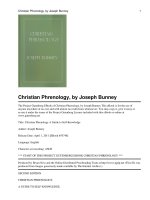Short Guide to Hepatitis C_2 pptx
Bạn đang xem bản rút gọn của tài liệu. Xem và tải ngay bản đầy đủ của tài liệu tại đây (1.19 MB, 13 trang )
14 | Hepatitis C Guide
Transmission
Parenteral exposure to the hepatitis C virus is the most
efficient means of transmission. The majority of patients
infected with HCV in Europe and the United States acquired the
disease through intravenous drug use or blood transfusion,
which has become rare since routine testing of the blood supply
for HCV began. The following possible routes of infection have
been identified in blood donors (in descending order of
transmission risk):
• Injection drug use
• Blood transfusion
• Sex with an intravenous drug user
• Having been in jail more than three days
• Religious scarification
• Having been struck or cut with a bloody object
• Pierced ears or body parts
• Immunoglobulin injection
Very often in patients with newly diagnosed HCV infection no
clear risk factor can be identified.
Factors that may increase the risk of HCV infection include
greater numbers of sex partners, history of sexually transmitted
diseases, and failure to use a condom. Whether underlying HIV
infection increases the risk of heterosexual HCV transmission to
an uninfected partner is unclear. The seroprevalence of HCV in
MSM (men who have sex with men) ranges from about 4 to 8%,
which is higher than the HCV prevalence reported for general
European populations.
The risk of perinatal transmission of HCV in HCV RNA positive
mothers is estimated to be 5% or less (Ohto 1994). Caesarean
This is trial version
www.adultpdf.com
1. Epidemiology, Transmission and Natural History | 15
section has not been shown to reduce transmission. There is no
evidence that breastfeeding is a risk factor.
Hemodialysis risk factors include blood transfusions, the
duration of hemodialysis, the prevalence of HCV infection in the
dialysis unit, and the type of dialysis. The risk is higher with
in-hospital hemodialysis vs peritoneal dialysis.
Contaminated medical equipment, traditional medicine rites,
tattooing, and body piercing are considered rare transmission
routes.
There is some risk of HCV transmission for health care
workers after unintentional needle-stick injury or exposure to
other sharp objects.
Acute Hepatitis
After HCV inoculation, there is a variable incubation period.
HCV RNA in blood (or liver) can be detected by PCR within
several days to eight weeks (Hoofnagle 1997). Aminotransferases
become elevated approximately 6-12 weeks after exposure
(range 1-26 weeks) and they tend to be more than 10-30 times
the upper limit of normal. HCV antibodies can be found about 8
weeks after exposure although it may take several months.
However, the majority of newly infected patients will be
asymptomatic and have a clinically non-apparent or mild course.
Periodic screening for infection may be warranted in certain
groups of patients who are at high risk for infection, e.g.,
homosexually active patients with HIV infection. Symptoms
include malaise, nausea, and right upper quadrant pain. In
patients who experience such symptoms, the illness typically
lasts for 2-12 weeks. Along with clinical resolution of symptoms,
aminotransferases will normalize in about 40% of patients. Loss
of HCV RNA, which indicates a hepatitis C cure, occurs in fewer
than 20% of patients. Fulminant hepatic failure due to acute HCV
This is trial version
www.adultpdf.com
16 | Hepatitis C Guide
infection may happen in patients with underlying chronic
hepatitis B virus infection (Chu 1999).
Chronic Hepatitis
The risk of chronic HCV infection is high. About 75% of
patients with acute hepatitis C do not eliminate HCV RNA and
progress to chronic infection. Most of these will have
persistently elevated liver enzymes in follow-up. Hepatitis C is
considered to be chronic after six months. Once chronic
infection is established, there is a very low rate of spontaneous
clearance.
Most patients with chronic infection are asymptomatic or have
only mild nonspecific symptoms as long as cirrhosis is not
present (Lauer 2001, Merican 1993). The most frequent
complaint is fatigue. Less common manifestations are nausea,
weakness, myalgia, arthralgia, and weight loss (Merican 1993).
Aminotransferase levels can vary considerably over the
natural history of chronic hepatitis C.
Natural History
The risk of developing cirrhosis within 20 years is estimated to
be around 10 to 20%, with some studies showing estimates of up
to 50% (de Ledinghen 2007, Poynard 1997, Sangiovanni 2006,
Wiese 2000). About 30% of patients will not develop cirrhosis for
at least 50 years (Poynard 1997). It is not completely understood
why there are such differences in disease progression. An
influence of host and viral factors has to be assumed.
Cirrhosis and Hepatic Decompensation
Complications of hepatitis C occur almost exclusively in
patients who have developed cirrhosis. Non-liver-related
mortality is higher in cirrhotic patients as well.
This is trial version
www.adultpdf.com
1. Epidemiology, Transmission and Natural History | 17
The risk for decompensation is estimated to be close to 5% per
year in cirrhotics (Poynard 1997). Once decompensation has
developed the 5-year survival rate is roughly 50% (Planas 2004).
Liver transplantation is then the only effective therapy.
Hepatocellular carcinoma (HCC) also develops solely in patients
with cirrhosis (in contrast to chronic hepatitis B).
Disease progression
Chronic HCV progression may differ due to several factors.
Other factors not yet identified may also be important.
Age and gender: More rapid progression is seen in males
older than 40-55 (Svirtlih 2007), while a less rapid progression is
seen in children (Child 1964).
Ethnic background: A slower progression has been noted in
African-Americans (Sterling 2004).
HCV-specific cellular immune response: Genetic
determinants like HLA expression (Hraber 2007).
Alcohol intake: Even moderate amounts of alcohol increase
HCV replication, enhance the progression of chronic HCV, and
accelerate liver injury (Gitto 2008).
Daily use of marijuana: may cause a more rapid progression.
Other host factors: TGF B1 phenotype and fibrosis stage are
correlated with fibrosis progression rate. Moderate to severe
steatosis correlates with developing hepatic fibrosis.
Viral coinfection: HCV progression is more rapid in
HIV-infected patients. Acute hepatitis B in a patient with chronic
hepatitis C may be more severe. Liver damage is usually worse
and progression faster in patients with dual HBV/HCV
infections.
Geography and environmental factors: Clear, but not
understood (Lim 2008).
Use of steroids: increases HCV viral load.
This is trial version
www.adultpdf.com
This is trial version
www.adultpdf.com
2. HCV - Structure and Viral Replication | 19
2. HCV - Structure and Viral Replication
Bernd Kupfer
Taxonomy and Genotypes
The hepatitis C virus (HCV) is in the Hepacivirus genus of the
Flaviviridae family. To date, six major HCV genotypes with a
large number of subtypes within each genotype are known
(Simmonds 2005). The high replication rate of the virus together
with the error-prone RNA polymerase of HCV is responsible for
the large interpatient genetic diversity of HCV strains.
Moreover, the extent of viral diversification of HCV strains
within a single HCV-positive individual increases significantly
over time resulting in the development of quasispecies (Bukh
1995).
Viral Structure
Structural analyses of HCV virions are very limited because for
a long time the virus was difficult to cultivate in cell culture
systems, a prerequisite for yielding sufficient virions for electron
microscopy. Moreover, serum-derived virus particles are
associated with serum low-density lipoproteins (Thomssen
This is trial version
www.adultpdf.com
20 | Hepatitis C Guide
1992), which makes it difficult to isolate virions from
serum/plasma of subjects via centrifugation.
It has been shown that HCV virions isolated from cell culture
have a spherical envelope containing tetramers (or dimer of
heterodimers) of the HCV E1 and E2 glycoproteins (Heller 2005,
Wakita 2005, Yu 2007). Inside the virions a spherical structure
has been observed (Wakita 2005) representing the nucleocapsid
(core) that harbours the viral genome.
Figure 2.1. Genome organization and polyprotein processing. A) Nucle-
otide positions correspond to the HCV strain H77 genotype 1a, accession
number NC_004102. nt, nucleotide; NTR, nontranslated region. B) Cleavage
sites within the HCV precursor polyprotein for the cellular signal peptidase,
the signal peptide peptidase (SPP) and the viral proteases NS2-NS3 and
NS3-NS4A, respectively.
Genome Organization
The genome of the hepatitis C virus consists of one 9.6 kb
single-stranded RNA molecule with positive polarity. Similar to
other positive-strand RNA viruses, the genomic RNA of hepatitis
C virus serves as messenger RNA (mRNA) for the translation of
viral proteins. The linear molecule contains a single open
reading frame (ORF) coding for a precursor polyprotein of
This is trial version
www.adultpdf.com
2. HCV - Structure and Viral Replication | 21
approximately 3000 amino acid residues flanked by two
regulatory nontranslated regions (NTR) (Figure 2.1).
Table 2.1 – Size and main function of HCV proteins. MW, molecular
weight in kd (kilodalton).
Protein MW Function
Core 21 kd Capsid-forming protein. Regulatory functions in
translation, RNA replication, and particle
assembly.
F-protein or ARFP 16-17 kd Unknown.
Envelope
glycoprotein 1
(E1)
35 kd Transmembrane glycoprotein in the viral
envelope. Adsorption, receptor-mediated
endocytosis.
Envelope
glycoprotein 2
(E2)
70 kd Transmembrane glycoprotein in the viral
envelope. Adsorption, receptor-mediated
endocytosis.
p7 7 kd Forms an ion-channel in the endoplasmic
reticulum. Essential formation of infectious
virions.
NS2 21 kd Portion of the NS2-3 protease which catalyses
cleavage of the polyprotein precursor between NS2
and NS3 (Figure 2.1).
NS3 70 kd NS2-NS3 protease, cleavage of the downstream
HCV proteins (Figure 2.1). ATPase/helicase
activity, binding and unwinding of viral RNA.
NS4A 4 kd Cofactor of the NS3-NS4A protease.
NS4B 27 kd Crucial in HCV replication. Induces membranous
web at the ER during HCV RNA replication.
NS5A 56 kd Multi-functional phosphoprotein. Contains the IFN
sensitivity-determining region (ISDR) that playsα
a significant role in the response to IFN -basedα
therapy
NS5B 66 kd Viral RNA-dependent RNA polymerase. NS5B is an
error-prone enzyme that incorporates wrong
ribonucleotides at a rate of approximately 10
-3
per
nucleotide per generation.
HCV Proteins
Translation of the HCV polyprotein is initiated through
involvement of some domains in the NTRs of the genomic HCV
RNA. The resulting polyprotein consists of ten proteins that are
This is trial version
www.adultpdf.com
22 | Hepatitis C Guide
co-translationally or post-translationally cleaved from the
polyprotein. In addition, the F (frameshift) or ARF (alternate
reading frame) protein has been explored (Walewski 2001).
During translation ARFP is the product of ribosomal
frameshifting within the core protein-encoding region.
Viral Lifecycle
The recent development of small animal models and more
efficient in vitro HCV replication systems has offered the
opportunity to analyse in detail the different steps of viral
replication (Figure 2.2).
Figure 2.2. Model of the HCV lifecycle. Designations of cellular
components are in italics. For a detailed illustration of viral translation and
RNA replication, see Pawlotsky 2007. HCV +ssRNA, single stranded genomic
HCV RNA with positive polarity; rough ER, rough endoplasmic reticulum;
PM, plasma membrane. For other abbreviations see text.
This is trial version
www.adultpdf.com
2. HCV - Structure and Viral Replication | 23
Adsorption and viral entry
Entry of HCV into a target cell is complex. A cascade of
virus-cell interactions is necessary for the infection of
hepatocytes and the precise mechanism of viral entry is not
completely understood. The current model of viral adsorption
assumes that HCV is associated with low-density lipoproteins
(LDL). The binding step includes binding of the LDL component
to the LDL-receptor (LDL-R) on the cell surface (Agnello 1999)
and simultaneous interaction of the viral glycoproteins with
cellular glycosaminoglycans (GAG) (Germi 2002). This initiation
step is followed by consecutive interactions of HCV with
scavenger receptor B type I (SR-BI) (Scarselli 2002) and the
tetraspanin CD81 (Pileri 1998). More recent findings indicate
subsequent transfer of the virus to the tight junctions, a protein
complex located between adjacent hepatocytes. Two
components of tight junctions, Claudin-1 (CLDN1) and occluding
(OCLN) have been shown to interact with HCV (Evans 2007, Ploss
2009). Although the precise mechanism of HCV uptake in
hepatocytes is still not clarified, these cellular components may
represent the complete set of host cell factors necessary for
cell-free HCV entry. Interaction of HCV with CLDN1 and OCLN
seems to induce the internalisation of the virion via
clathrin-mediated endocytosis (Hsu 2003). Subsequent HCV
E1-E2 glycoprotein mediation fuses the viral envelope with the
endosome membrane (Meertens 2006).
Translation and posttranslational processes
As a result of the fusion of the viral envelope and the
endosomic membrane, the genomic HCV RNA is released into the
cytoplasm of the cell (uncoating). The viral genomic RNA
possesses a nontranslated region (NTR) at each terminus. It
contains an internal ribosome entry side (IRES) involved in
This is trial version
www.adultpdf.com
24 | Hepatitis C Guide
ribosome-binding and subsequent initiation of translation
(Tsukiyama-Kohara 1992). The synthesized HCV precursor
polyprotein is subsequently processed by at least four distinct
peptidases. The cellular signal peptidase (SP) cleaves the
N-terminal viral protein’s immature core protein, E1, E2, and p7
(Hijikata 1991), while the cellular signal peptide peptidase (SPP)
is responsible for the cleavage of the E1 signal sequence from the
C-terminus of the immature core protein, resulting in the
mature form of the core (McLauchlan 2002). The E1 and E2
proteins remain within the lumen of the ER where they are
subsequently N-glycosylated with E1 having 5 and E2 harbouring
11 putative N-glycosylation sites (Duvet 2002). The remaining
HCV proteins are posttranslationally cleaved by the viral
NS2-NS3 and the NS3-NS4A protease, respectively.
HCV RNA replication
The complex process of HCV RNA replication is poorly
understood. The key enzyme for viral RNA replication is NS5B,
an RNA-dependent RNA polymerase (RdRp) of HCV. After the
RdRp has bound to its template the NS3 helicase is assumed to
unwind putative secondary structures of the template RNA in
order to facilitate the synthesis of minus-strand RNA (Jin 1995,
Kim 1995). In turn, the newly synthesized antisense RNA
molecule serves as the template for the synthesis of numerous
plus-stranded RNA. The resulting sense RNA may be used
subsequently as genomic RNA for HCV progeny as well as for
polyprotein translation. Another important viral factor for the
formation of the replication complex appears to be NS4B, which
is able to induce an ER-derived membranous web containing
most of the non-structural HCV proteins including NS5B (Egger
2002).
This is trial version
www.adultpdf.com
2. HCV - Structure and Viral Replication | 25
Assembly and release
After the viral proteins, glycoproteins, and the genomic HCV
RNA have been synthesized these components have to be
arranged in order to produce infectious virions. Viral assembly is
a multi-step procedure involving most viral components along
with many cellular factors. Recent findings suggest that viral
assembly takes place within the endoplasmic reticulum
(Gastaminza 2008) and that lipid droplets are involved in particle
formation (Miyanari 2007, Shavinskaya 2007). However, the
precise mechanisms for the formation and release of infectious
HCV particles are still unknown.
This is trial version
www.adultpdf.com
26 | Hepatitis C Guide
3. Diagnostic Tests in Acute and Chronic
Hepatitis C
Christian Lange and Christoph Sarrazin
Hepatitis C is often diagnosed accidentally and, unfortunately,
remains heavily under-diagnosed. HCV diagnostics should be
performed thoroughly in all patients presenting with increased
aminotransferase levels, with chronic liver disease of unclear
aetiology and with a history of enhanced risk of HCV
transmission.
Serologic Assays
With 2nd generation enzyme-linked immunoassays (EIAs),
HCV-specific antibodies can be detected approximately 10 weeks
after infection (Pawlotsky 2003b). To narrow the diagnostic
window from viral transmission to positive serological results, a
3rd generation EIA has been introduced that includes an antigen
from the NS5 region and/or the substitution of a highly
immunogenic NS3 epitope, allowing the detection of anti-HCV
antibodies approximately four to six weeks after infection with a
sensitivity of more than 99% (Colin 2001). Anti-HCV IgM
measurement can narrow the diagnostic window in only a
This is trial version
www.adultpdf.com









